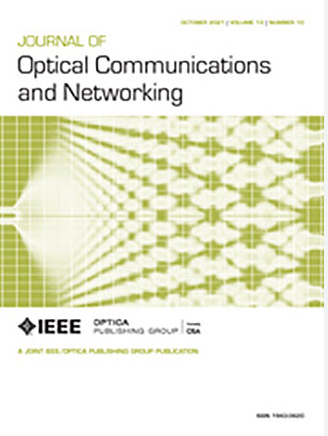光学网络设计与建模导论2024年特刊
IF 4.3
2区 计算机科学
Q1 COMPUTER SCIENCE, HARDWARE & ARCHITECTURE
引用次数: 0
摘要
在本期特刊中,我们收录了八篇论文,这些论文是从第28届国际光网络设计与建模会议2024 (ONDM 2024)上发表的会议论文扩展而来的,该会议的口号是“大规模光网络:应对未来智能网络的可扩展性挑战”。本次会议和本期特刊的目的是选择光网络架构、控制、建模和规划技术方面的最新研究成果,推动下一代网络的设计,以应对无处不在的通用绿色人工智能的挑战。该工作的总体研究目标是以可扩展的方式提高光接入和传输网络的容量、效率、灵活性、可用性、自主性、弹性、安全性和智能。下面所描述的选定作品应对了这一挑战,首先研究了用于光传输网络的数字孪生的设计,研究了故障检测和灾后数据中心内容疏散的先进机制。第二,通过引入量子技术。事实上,包括量子在内的入选作品的数量揭示了对这一主题日益增长的兴趣:一方面,应用基于量子计算的算法来解决经典的光网络问题,作为ILP的替代方案,另一方面,关注能够与使用光纤或自由空间光学的经典通道共存的新量子密钥分发技术。本文章由计算机程序翻译,如有差异,请以英文原文为准。
Introduction to the Optical Networks Design and Modeling 2024 Special Issue
In this special issue, we include eight papers that were extended from the conference papers presented at the 28th International Conference on Optical Networks Design and Modeling 2024 (ONDM 2024), whose motto was “Optical networks at scale: coping with the scalability challenge of future smart networks.” The objective of the conference and this special issue is the selection of the latest research on optical network architectures, control, modeling, and planning techniques driving the design of next-generation networks to meet the challenges of ubiquitous universal green AI. The overall research goal of the works is improving the capacity, efficiency, flexibility, availability, autonomy, resiliency, security, and intelligence of optical access and transport networks in a scalable way. The selected works described below meet the challenge, first looking into the design of digital twins for optical transport networks, investigating advanced mechanisms for failure detection and post-disaster data center content evacuation. Second, through the introduction of quantum technologies. Indeed, the amount of selected works including quantum reveals the growing interest on this topic: on the one hand, the application of quantum-computing-based algorithms to solve classic optical networking problems as an alternative to ILP, and, on the other, the focus on new quantum key distribution technologies capable of coexisting with classical channels either using optical fiber or free space optics.
求助全文
通过发布文献求助,成功后即可免费获取论文全文。
去求助
来源期刊
CiteScore
9.40
自引率
16.00%
发文量
104
审稿时长
4 months
期刊介绍:
The scope of the Journal includes advances in the state-of-the-art of optical networking science, technology, and engineering. Both theoretical contributions (including new techniques, concepts, analyses, and economic studies) and practical contributions (including optical networking experiments, prototypes, and new applications) are encouraged. Subareas of interest include the architecture and design of optical networks, optical network survivability and security, software-defined optical networking, elastic optical networks, data and control plane advances, network management related innovation, and optical access networks. Enabling technologies and their applications are suitable topics only if the results are shown to directly impact optical networking beyond simple point-to-point networks.

 求助内容:
求助内容: 应助结果提醒方式:
应助结果提醒方式:


